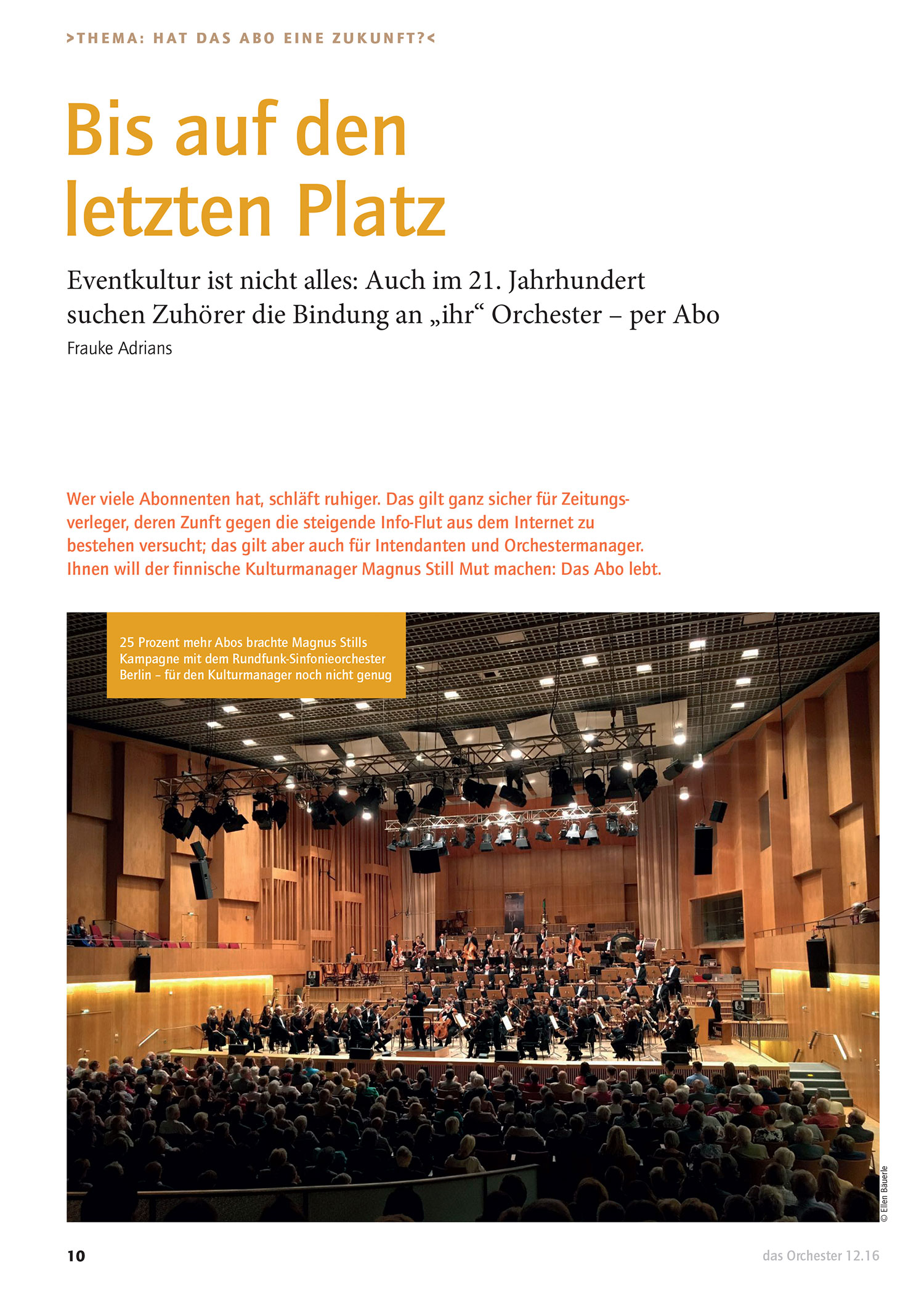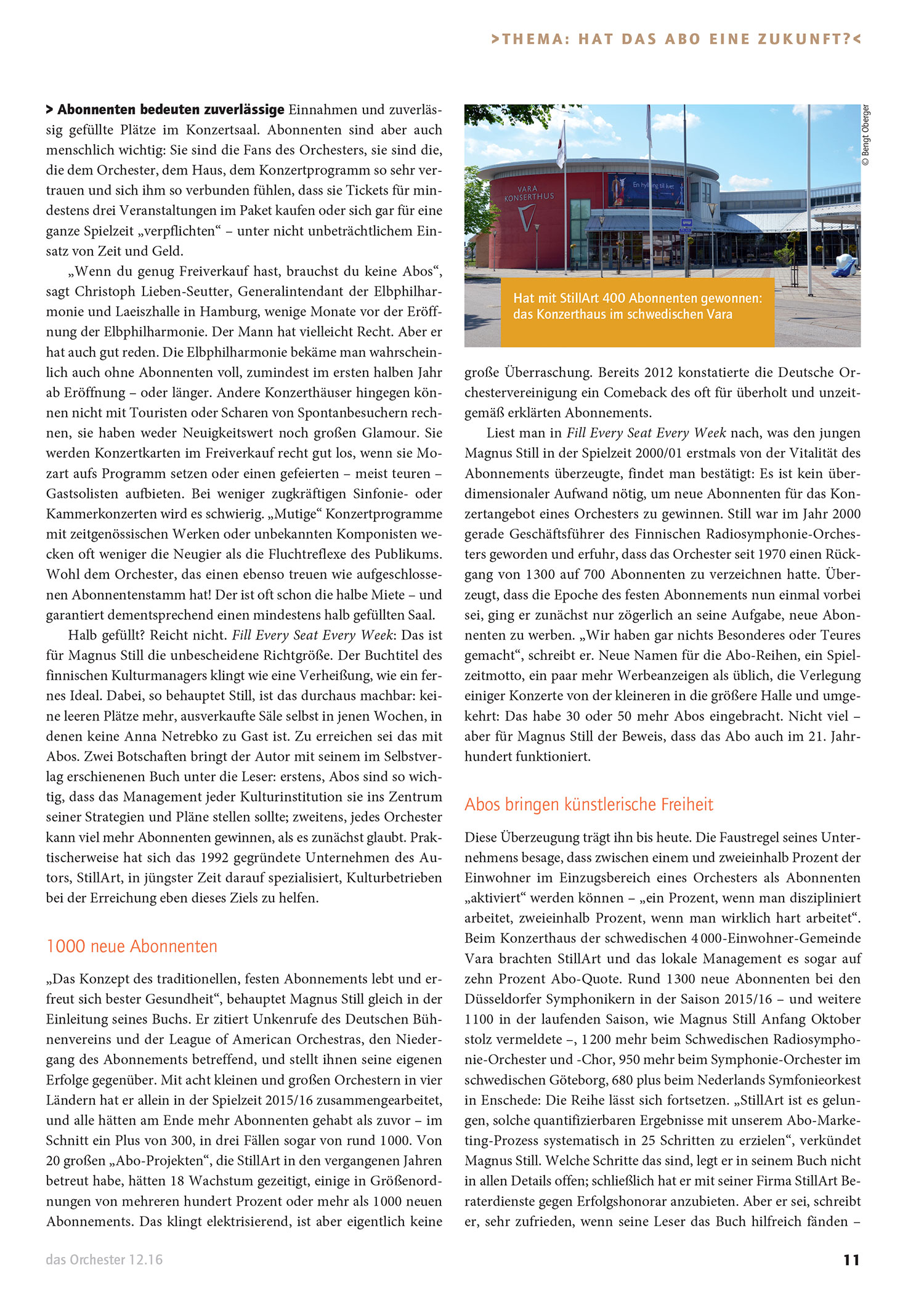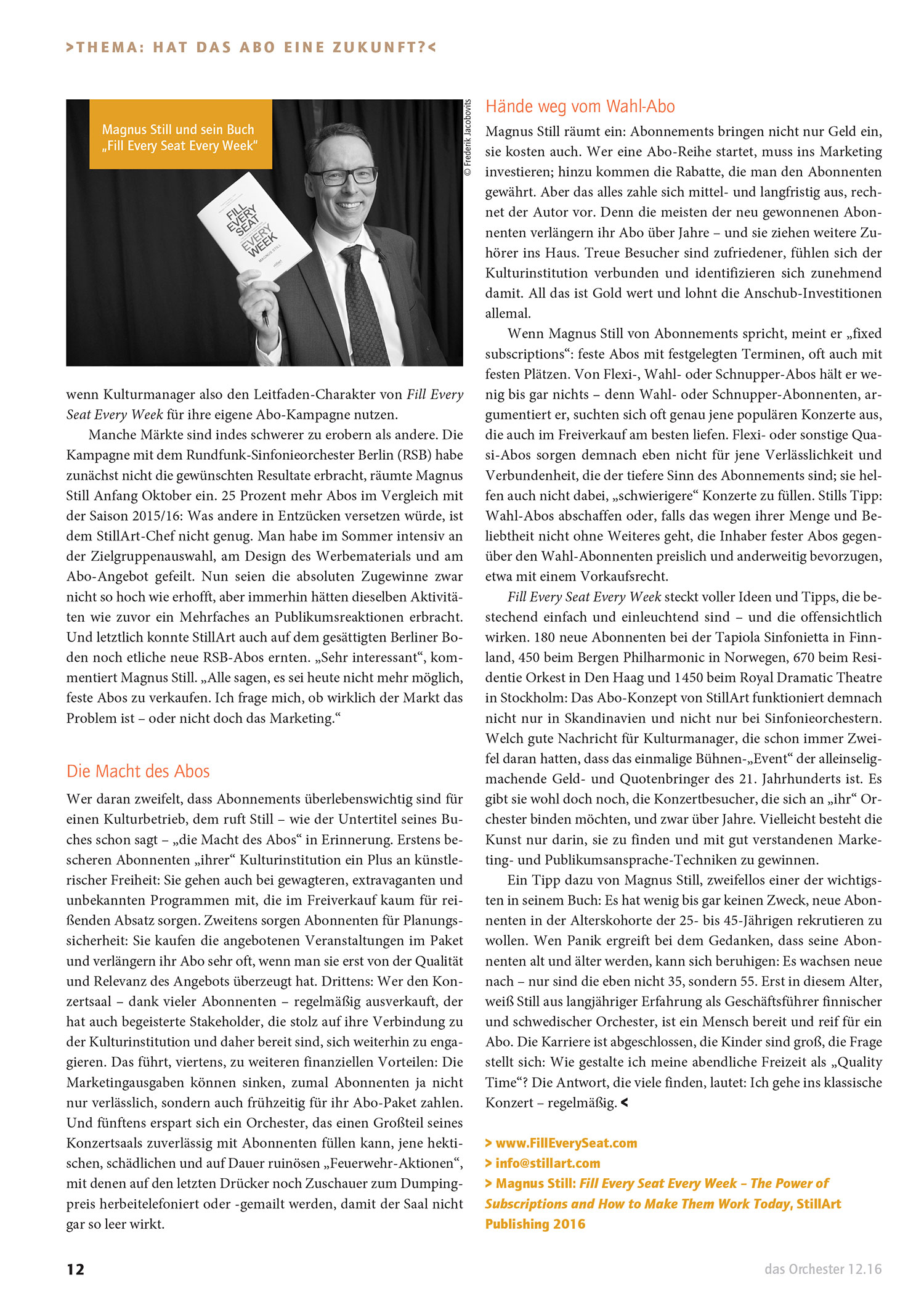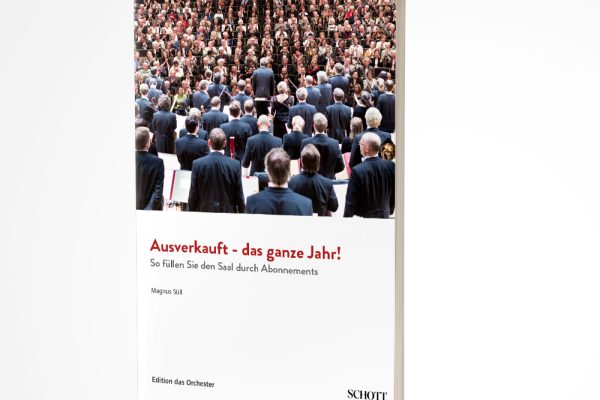Das Orchester December 2016 Features Subscriptions and Fill Every Seat
05th Jan 2017

Event Culture is not everything. Even in the 21st century, listeners seek a connection to “their” orchestra – with subscriptions >>> Frauke Adrians – Das Orchester
Anyone who sells a lot of subscriptions sleeps easier. This is certainly true for newspaper publishers trying to battle the rising flood of information from the Internet, but it also applies to directors of orchestras and other cultural institutions. The Finnish arts manager Magnus Still has encouraging words for them all: the subscription lives!
Magnus Still’s campaign with the Radio Symphony Orchestra Berlin brought a 25% increase in subscription sales – the arts manager believes there is room for even more.
Subscribers mean reliable income and consistently filled seats in concert halls. But subscribers are also important from a human standpoint; they are an orchestra’s fans. They are the ones with enough trust and loyalty to an orchestra, a hall, or a particular programming concept to be willing to purchase tickets for at least three events, or even to commit themselves to an entire season – a considerable investment of time and money.
As Christoph Lieben-Seutter – Intendant of the Laeiszhalle and the new Elbphilharmonie in Hamburg – said a few months before the opening of the new hall, “If you have enough single ticket sales, you don’t need subscriptions.” He may be right, but he also is in a very comfortable situation. One could probably easily fill Hamburg’s new concert hall for the first year or even longer without subscriptions. Other halls, however, cannot count on hordes of tourists or spontaneous visitors, and they cannot offer novelty or glamor. They can sell a fair number of individual tickets if Mozart is on the program, or if a famous – and usually expensive – guest soloist is performing. But it quickly becomes more difficult for less popular chamber music or symphony programs. “Adventurous” concerts featuring unknown composers or contemporary works meant to awaken audiences’ curiosity often send them fleeing in the opposite direction instead. An orchestra with loyal and open-minded subscribers is lucky indeed! This can guarantee that at least half the seats will always be filled – and that, hopefully, at least half the rent will be paid.
Half the seats? That is not enough. The title of Finnish arts manager Magnus Still’s book, Fill Every Seat Every Week, states his immodest goal. This may seem like a distant ideal, or a mirage, yet Still claims it is eminently possible: no more empty seats, and sold-out halls even in those weeks when Anna Netrebko is not in town. The secret is subscriptions. The author presents two messages in his self-published book. First, subscriptions are so important that the management of every cultural institution should make them the centerpiece of their strategies and planning. Second, all orchestras can attract many more subscribers than they initially believe. Conveniently, StillArt – founded by Still in 1992 – has become a specialist in helping cultural institutions reach this goal.
400 new subscribers with StillArt: the concert hall in the Swedish town of Vara
1000 New Subscribers
“The concept of traditional season-ticket subscriptions is alive and well,” is Magnus Still’s bold claim in the introduction to his book. He counters prophets of doom concerning subscriptions – such as the German Theater Association or the League of American Orchestras – with accounts of his own successes. In the 2015/16 season alone, Still worked with eight large and small orchestras in four countries. At the end of the season, all had more subscribers than before – 300 on average, and in three cases more than 1000. Out of 20 large subscription projects directed by StillArt in the past few years, 18 resulted in growth, some at the level of several hundred percent or more than 1000 new subscribers. This seems electrifying, but it is not really surprising. As long ago as 2012, the German Orchestra Musicians’ Union noted a comeback of the allegedly outmoded subscription model.
Fill Every Seat Every Week confirms what the young Magnus Still learned as early as the year 2000 about the vitality of subscriptions. Superhuman efforts are not required to attract new subscribers to an orchestra’s concerts. In 2000, Still had just been appointed manager of the Finnish Radio Symphony Orchestra, and was informed that since 1970 the number of subscribers had declined from 1,300 to 700. Seeing this as proof that the age of subscriptions was over, he only slowly made attempts to gain new subscribers. “We didn’t do anything unusual or expensive,” he writes. New titles for the subscription series, an overall theme for the entire season, the relocation of some concerts from the small hall to the large and vice versa – this nevertheless resulted in 30 or possibly 50 more subscriptions, and convinced Magnus Still that subscriptions could still be relevant.

Subscriptions Provide Artistic Freedom
Magnus Still remains convinced of the importance of subscriptions in the 21st century. His company’s rule of thumb is that between 1 and 2.5% of the population in the area served by an orchestra can be “activated” as subscribers: “1% if you work with discipline, and 2.5% if you work really hard.” In the Swedish town of Vara, with a population of only 4,000, StillArt and the local management team were even able to reach a quota of 10%. 1,300 new subscribers for the Düsseldorf Symphony in the 2015/16 season (and 1,100 more in the current season, as Still proudly noted in October 2016), a gain of 1,200 for the Swedish Radio Symphony Orchestra and Choir, 950 more for the Gothenburg Symphony, 680 new subscribers for the Netherlands Symphony in Enschede – the list could go on and on. “StillArt has achieved these quantifiable results with our 22-step subscription marketing plan,” according to Magnus Still. He does not provide full details of these steps in his book, since he and his firm offer a consulting service with a fee based on the success of their efforts. But he writes that he will be very happy if readers find his book helpful, and if arts managers use the suggestions in Fill Every Seat Every Week to improve their own subscription campaigns.
It is true that some markets are more difficult than others. In October 2016, Magnus Still conceded that the campaign for the Radio Symphony Orchestra in Berlin (RSB) did not initially achieve the expected results. 25% more subscriptions than in the previous season might send others into raptures of joy, but for Still they were not enough; in the summer, there were intensive continued efforts to define the target audience, the advertising design, and the subscription offerings. The absolute gains were not as great as expected, but audience reaction was enthusiastic and a significant number of new subscriptions were sold, even in the saturated and competitive cultural market of Berlin. “It’s very interesting,” observes Still. “Everyone says it is no longer possible to sell fixed subscriptions. I wonder whether the problem is really with the market – or with the marketing.”

Magnus Still and his book, Fill Every Seat Every Week
The Power of Subscriptions
Magnus Still encourages those skeptics who question the necessity of subscriptions for the survival of cultural institutions to consider “The Power of Subscriptions,” the subtitle of his book. For one thing, subscribers provide “their” institution with an added degree of artistic freedom, because they also attend programs featuring unconventional, controversial, or little-known works that do not produce a large number of conventional ticket sales. Second, subscribers also provide certainty for planning. They purchase the performances on offer as a package, and often repeatedly extend their subscription once they are convinced of the quality and relevance of the programming. Third, an institution that regularly sells out a hall – thanks to a large number of subscribers – possesses a pool of enthusiastic stakeholders proud of their relationship to the institution and ready to provide continued support. This in turn leads to further financial advantages, a fourth factor: marketing costs are reduced, and subscribers – in addition to being a reliable source of income – also pay early for their subscription package. And an important fifth factor is the ability of orchestras consistently able to fill their halls with subscribers to avoid hectic – and in the long run financially ruinous – last minute “fire brigade” actions to drum up listeners simply to fill the empty seats.
Avoid Flexible Subscriptions
Magnus Still concedes that subscriptions not only produce income, they cost money as well. Anyone starting a subscription series must invest in marketing; the discounts offered to subscribers take their toll as well. But according to the author, these efforts pay for themselves in the medium to long term, because the majority of subscribers extend their subscriptions for years – and they in turn recruit further listeners. Loyal listeners are happier. They feel a sense of connection to the institution and come to identify with it. All this is worth its weight in gold and more than justifies the initial investments.
When Magnus Still speaks of subscriptions, he means “fixed subscriptions” with set dates and seating assignments. He has little or no use for so-called “flexible” or “pick and choose” subscriptions, because such subscribers usually select the most popular concerts that are easy to sell anyway. Flexible or other quasi-subscriptions do not provide the stability and loyalty that are the true reasons for subscriptions; they also do not help fill “difficult” concerts. Still recommends the elimination of flexible subscriptions or, if they are currently so popular that this does not seem advisable, to provide fixed subscribers with added enticements, both financial and otherwise – such as advance booking privileges.
Fill Every Seat Every Week is full of ideas and tips that are surprisingly simple and reasonable, and which are apparently effective: 180 new subscribers for the Tapiola Sinfonietta in Finland, 450 for the Bergen Philharmonic in Norway, 670 for the Hague Philharmonic, and 1450 for the Royal Dramatic Theatre in Stockholm. StillArt’s subscription concept seems to really work, not only in Scandinavia and not only for symphony orchestras. This is good news for managers, many of whom have always secretly doubted that one-time “Events” are the only magic wand able to produce profits and audience numbers in the 21st century. There really are still audience members eager and willing to commit themselves to “their” orchestra, even for many years. Perhaps the trick is simply to find them and win them over with intelligent and effective marketing and audience targeting techniques.
One tip from Magnus Still is without doubt among the most important in his book: there is little or no point in trying to recruit new subscribers between the ages of 25 and 45. Nonetheless, panicking managers worried that their audiences will become ever more geriatric can relax. There will always be new subscribers to replace them, but they are more likely to be 55 than 35. His long experience as Managing Director of Finnish and Swedish orchestras has taught Still that only at this age are most people mature enough to become long-term subscribers. Their careers are stable or nearing an end, the children are grown, and the question becomes how to turn their increased leisure time into “quality time.” The answer that many discover is: “Let’s go to a classical concert – regularly.”
Magnus Still: Fill Every Seat Every Week – The Power of Subscriptions and How to Make Them Work Today, StillArt Publishing 2016







